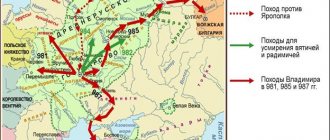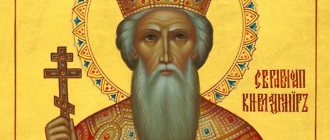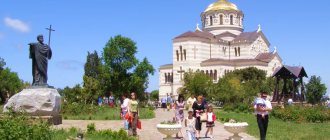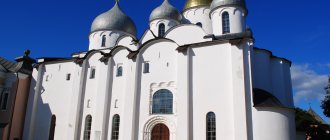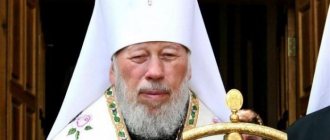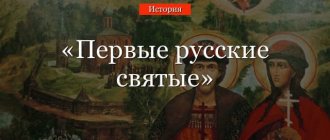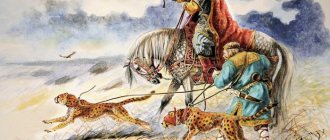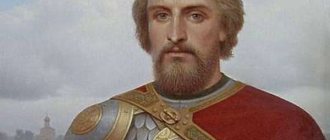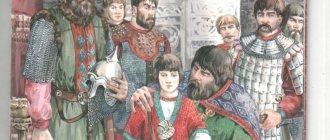How Prince Vladimir was baptized
On May 27, the relics of Saint Equal-to-the-Apostles Prince Vladimir will leave the Cathedral of Christ the Savior in Moscow on a journey through the cities of Russia and Belarus.
Until December 1, residents of 45 Russian and five Belarusian cities will be able to venerate the shrine. The bringing of the relics is one of the key events in honor of the millennium of the repose of Saint Prince Vladimir. “Russian Planet” recalls under what circumstances the prince who became a saint was baptized, whether ambassadors from different faiths really visited him, and whether the phrase that “Joy in Rus' is drinking” was actually uttered.
Test of faith
The Tale of Bygone Years testifies: in 986, Prince Vladimir was visited by four delegations - from the Mohammedan Bulgarians, from the “Latins” from Rome, from the Khazar Jews and from the Byzantine Greeks. They all hoped to persuade the Russian prince to their faith by presenting its advantages. Of all the delegates, Vladimir spent the longest time talking with the envoy from Byzantium, and rejected all other visitors quite quickly.
He asked the Mohammedans (Muslims): “What is your faith?” And they told the prince about circumcision and the ban on wine and pork. But for this, they said, “Mohammed will give each of them seventy beautiful wives” (Hereinafter, quotations from the chronicle are given in the translation of Academician D.S. Likhachev - RP). Vladimir “listened to them to his heart’s content - because he himself loved his wives. But here’s what he didn’t like: circumcision and abstinence from pork. And about drinking, on the contrary, he said: “Rus' has joy in drinking.”
The Russian prince sent away the Roman “Latins” who came after the Bulgarians with the words: “Go where you came from, for our fathers did not accept this.” And the Khazar Jews asked where their land was, and, having heard that God had scattered the Jews across different lands, he concluded: “If God had loved you and your law, then you would not have been scattered across foreign lands. Or do you want the same for us?”
Vladimir listened to the Byzantine envoy, whom the chronicle calls a “philosopher,” for a long time and with interest, but still did not make a final decision on the choice of faith.
The next year (987), the prince himself sent messengers to different lands to find out “who serves God as God.” The messengers returned, most impressed by the service in Constantinople (Constantinople): “They didn’t know where we were - in heaven or on earth, for there is no such spectacle and such beauty on earth.” It was then that the prince decided to be baptized according to the Greek rite, and the boyars supported him.
The question of transformation
Historians ask the question: why did Vladimir need to change his faith at all? Why and how did the turn take place that turned a pagan into a Christian?
The chronicle only complicates the search for an answer, reporting: just a few years before baptism, Vladimir erected pagan idols in Kyiv. And after one of the successful campaigns, he made a human sacrifice to the gods, the lot fell on the Christian youth, and when his Varangian father stood up for him, they killed both.
The path “from the Varangians to the Greeks” went through Rus', the brilliant Byzantium was at hand, Vladimir saw in Christianity a unifying principle for his lands and at the same time wanted to enter into kinship and become on a par with the Byzantine emperors. This interpretation is given by the Arab historians Yahya of Antioch (11th century) and Elmakin (12th century).
Old Russian sources, on the contrary, completely reject external reasons for the change of faith. Metropolitan Hilarion of Kiev (11th century) in his “Sermon on Law and Grace” writes: “A visit from the Most High came upon him. And his mind shone in his heart.” The monk Jacob Chernorizets (11th century) adheres to the same letter.
Archbishop Filaret (Gumilevsky) (19th century) summed up what was said in Russian chronicle texts as follows: “Terrible fratricide, victories bought with the blood of strangers and one’s own, coarse voluptuousness could not help but burden the conscience of even a pagan. Vladimir thought to ease his soul by erecting new idols on the banks of the Dnieper and Volkhov. But all this did not bring peace to the soul - the soul was looking for light and peace.”
The pavilion built on the supposed site of the baptism of Prince Vladimir and the Vladimir Cathedral in the national reserve "Chersonese Tauride". Photo: Artem Geodakyan / TASS
It is interesting that the version of the “test of faith” by Prince Vladimir, set out in the chronicle text, is also not accepted by all scientists. Professor Evgeniy Golubinsky in the 19th century stated that “all this is fiction, and this could not have happened” - just like the phrase about “there is fun in drinking in Rus'.” The scientist referred to the texts of the monk Jacob and Metropolitan Hilarion, written before the Tale of Bygone Years - none of them contain any mention of the fact that messengers came to Vladimir to “represent” their religions, and the described dialogues took place between them.
Farewell to Perun
Having chosen which faith to adhere to, the prince was not baptized immediately. In the summer of 988, Vladimir sent six thousand soldiers to Byzantium to help Emperor Vasily II stay on the throne - his own military leader was trying to remove him. In exchange for help, Vladimir was promised the hand of the emperor's sister, 26-year-old Anna.
The Greeks did not fulfill their part of the agreement, and then the prince went to take Anna by force, starting by besieging and taking the Byzantine Chersonese (Korsun) in the Crimea. “If you don’t give up Anna, I’ll do to the capital what I did to this city,” the chronicle quotes Vladimir as saying.
Greek law prohibited the issuance of offspring of the imperial family as unbaptized. This was the law established by Constantine the Great. The Greeks prayed: “Be baptized, and we will give up your sister.” At the same time, Anna herself did not want to marry the barbarian prince: she compared a possible marriage with captivity and declared that “it would be better for her to die here.” They convinced her: “Perhaps, with you, God will turn the Russian land to repentance, and you will save the Greek land from a terrible war.” Meanwhile, Vladimir finally made up his mind and answered the Greeks: “Let those who came with your sister baptize me.” Having learned from his relations with the Greeks, he first wanted to see the bride, and only then undergo the sacrament.
On the appointed day, a boat moored to the shore of Korsun. Anna was in it, and with her the dignitaries and elders. The chronicle reports that on this day Prince Vladimir went blind. Anna told him: “If you want to get rid of your illness, then be baptized as soon as possible. If you don’t get baptized, you won’t be able to get rid of your illness.” The chronicler summarizes: the bishop, having announced, baptized Vladimir, and when he laid his hand on him, he immediately received his sight.
Seeing this, following the prince, the squad was baptized. Upon returning home, to Kyiv, one of the first things they did was tear down the pagan idols: “Some were chopped up, others were burned. The prince ordered Perun to be tied to the tail of a horse and dragged from the mountain to the Dnieper and assigned 12 men to beat him with sticks.”
This was done not because the tree felt anything, the chronicler adds, but to mock the demon: “So that he would accept retribution from people.”
This interpretation is consonant with some patristic works. Official science associates the emergence of paganism with people’s ignorance of the world, thanks to which divine properties were attributed to the elements, not knowing how to explain them otherwise. At the same time, representatives of Christian thought often saw demons in pagan idols - linking this with the Old Testament episode of the book of Genesis about certain marital relations between the “sons of God” and “daughters of men” (by “sons of God” one of the theological versions means fallen angels cast down from heaven), the subsequent appearance of “giant giants” on earth and the depravity of humanity, which stopped the global flood. Thus, some Christians perceived pagan idols as monuments to demonic phenomena described in the Old Testament.
Returning to the life of St. Vladimir, let’s say that science argues here too, questioning the truth of the Korsun legend. Anton Kartashev, a church historian, citing the writings of the monk Jacob, states: Vladimir was baptized back in 987, and this probably happened in Kyiv or Vasilevo, where the prince’s “residence” was located. Vladimir took Korsun for the third summer after baptism, Kartashev believes.
Nikolai Karamzin, the author of “The History of the Russian State,” appeals to Kartashev in absentia: “It is enough that Vladimir, having accepted the Faith of the Savior, was sanctified by It in his heart and became a different person. His main right to eternal glory and gratitude of posterity is that he put the Russians on the path of the true Faith; but the name of the Great belongs to him also for state affairs. This Prince repelled the attacks of predatory neighbors, expanded the borders of the State in the West; tried to enlighten Russia, populated deserts, founded new cities; he founded schools and called from Greece not only Priests, but also artists; finally, he was a tender father of a poor people.”
Vladimir Svyatoslavich. The path to the Kyiv throne
Vladimir was the son of a slave, a captive Drevlyan princess (according to one hypothesis), and the Grand Duke of Kyiv Svyatoslav. Before his last campaign, Svyatoslav divided the Russian principality between his sons: the Kiev land went to Yaropolk, the Drevlyansk land to Oleg, the Novgorod land to Vladimir.
After the death of the prince in a battle with the Pechenegs, a mortal battle for the throne broke out between the brothers. Oleg fell in a battle with Yaropolk. Vladimir, realizing that a similar fate awaited him, equipped the boat and fled from his possessions to Scandinavia.
“Vladimir and Rogneda” based on the chronicle story about Rogneda, 1770 A.P. Losenko. (State Russian Museum)
Over 2 years of life in the Varangian lands, which consisted mainly of military campaigns, the character of King Valdemar, as Vladimir was called in Scandinavia, was finally formed. To the bravery and cruelty of the young prince, cunning and patience were added. Vladimir was waiting in the wings. And he waited. When Novgorod messengers came to him with a request to hire the best squad and overthrow the Kyiv governors installed by Yaropolk, the prince’s answer was laconic: “Go and tell my brother that Vladimir is coming against you.”
History24
Vladimir Svyatoslavich the Saint (ca. 960 – 1015)
Brief information on the facts of the Unified State Examination.
Vladimir came to power as a result of victory in the first civil strife between Yaropolk and Oleg. Vladimir I carried out a pagan reform (980), which failed. In 988 he baptized Rus'. Under him, defensive lines are being actively built around Kyiv. Annexes Cherven Rus (to the left of Kyiv on the map, in the area of modern Poland). He also started minting coins.
Unification of religious beliefs in Rus'
(K2) First, Vladimir I tried to carry out pagan religious reform and create a single pantheon led by Perun. He ordered the demolition of local places of worship and forced the population to profess the new pantheon, but this reform did not take root. Then Vladimir decided to introduce a monotheistic religion and chose Christianity according to the Eastern model. He went to Chersonesus, where he was baptized, and then forcibly baptized Rus'. Thanks to this, a single religion appeared in Ancient Rus', which contributed to the centralization of the state.
(K4) The adoption of Christianity determined the entire subsequent course of development of Russian history. Active borrowing of Christian culture from Byzantium began. For example, already under Yaroslav the Wise, the largest cathedral was built - the St. Sophia Cathedral in Kyiv, modeled on the St. Sophia Cathedral in Constantinople.
Expansion of the territory of the Old Russian state
(K2) Vladimir organized a series of campaigns with the aim of subjugating the East Slavic tribal unions and expanding the territory. So he started a war with the Polish prince and went on a campaign against Cherven Rus. He annexed Cherven and Przemysl, which became one of the territorial expansions.
(K4) The expansion of the territory of the Old Russian state, as well as the adoption of Christianity and familiarization with Christian culture led to the international recognition of Ancient Rus'. Under Yaroslav the Wise, this recognition would manifest itself in the active conclusion of dynastic marriages with European courts.
Combined personalities (Vladimir participated in these processes together with these personalities):
—
Cyril and Methodius
(spread of writing in Russia)
— Dobrynya - Vladimir's warrior
(spread of Christianity in Rus')
— Svyatoslav
(expansion of the territory of Ancient Rus')
— Yaroslav the Wise
(expansion of the territory of Ancient Rus', the spread of Christianity in Rus', centralization of power in Ancient Rus' - created general written legislation)
Source:
Dasha Dvoryanskaya - a story worth a hundred
In 988 the baptism of Russia
.
An important role was played by Vladimir 1
, who
chose
a new religion - Christianity,
made
a trip to Korsun, where
he was baptized
.
When Vladimir returned, he ordered
the entire population of the country to be baptized, and also
destroyed
the pantheon of gods in Kiev. Thanks to Vladimir's actions, many people in Rus' were baptized.
Source:
History | Unified State Exam 2021 | myClass
Baptism of Rus'
After the capture of Chersonesos, Prince Vladimir accepted
Christianity.
Returning to Kiev, he ordered
the pagan idols to be overturned; he
ordered
to be thrown into the Dnieper.
The next day I ordered
the people of Kiev came to the river, where the priests performed the rite of baptism over them.
After this, Vladimir ordered
the construction of churches to begin.
He allocated
a tenth of his income for the maintenance of the first stone church, after which it began to be called the Tithe Church.
Source:
Historica: preparation for the Unified State Exam in history
Vladimir I. Kiev reign
Gathering the Varangians, Slavs, Chuds and Krivichs under his banner, Vladimir moved to Kyiv in the summer of 978. The prince's main regiments moved on boats along the rivers, while the cavalry walked along the banks. But suddenly Vladimir changed direction - he went to Polotsk and dealt a sudden and crushing blow to the city. Having stabbed the Polotsk prince and his two sons, having raped the prince’s daughter Rogneda, who a few weeks earlier had the imprudence to offend Vladimir, who asked for her hand (“I will not marry the son of a slave,” were her words), Vladimir Svyatoslavich turned to Kyiv. He did not ruin the city, his future capital, but resorted to cunning. Having bribed the Kyiv governor Blud, Vladimir lured Yaropolk from Kyiv to Roden, where during negotiations he gave the order to two Varangians to raise his brother “to the sword.”
Having become the Grand Duke over Kiev and the entire Russian land, Vladimir understood that his victory was achieved to a greater extent because the pagan Kievites were dissatisfied with Yaropolk, who before his death communicated too closely with Christians, including the German king Otto I. Yes and the ex-prince’s wife was a Greek nun, who ultimately became Vladimir’s concubine.
Vladimir goes on a campaign against the Pechenegs. (runivers.ru)
The right to power had to be confirmed by military successes and the expansion of the borders of the state. Vladimir began to conquer the surrounding tribes. In 979, he made a campaign into the lands of the Volynians, which ended with their subjugation to Kyiv. In 981 he conquered the Vyatichi. Lyakhov, Przemysl, Cherven and many other cities could not resist the pressure of the Kyiv prince and his squad. In a long-term struggle, Vladimir managed to conquer the fierce Vyatichi tribe, the Radimichi tribe, and the Volga Bulgars. Having won victory over many peoples, the prince began to think seriously about choosing a new faith - a huge territory that did not have a common religion had to be retained.

